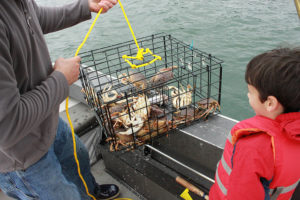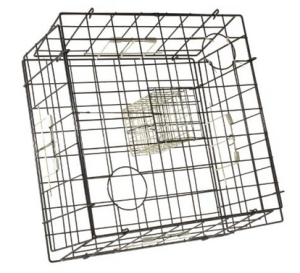How To Go Crabbing: Crab Pots
The Basics on Recreational Crabbing with Crab Pots:
Crabbing is the skill of capturing those feisty but delicious shellfish we call crabs. For recreational crabbers like you and I, there are a few, easy-to-learn methods for catchy these delightful critters. It requires absolutely NO prior experience and provides hours of fun for everyone.
 Crab pots are super effective traps and using them doesn’t really require much human intervention (i.e. set and forget). Crab pots are basically cages that have strategic openings in them that allow crabs to enter but not exit. Some have small openings so that smaller crabs get escape. Some also need to be turtle-friendly depending on the area in which you crab. They usually need to be heavy enough to stay stable on the floor of the ocean/river and also corrosive resistant to the water. Crab pots can be rectangular or circular. Using crab pots straddle the line between recreational crabbing and commercial crabbing. You should first know the rules and regulations for your particular crabbing region before taking home any amount of crab using crab pots. Multiple large crab pots are usually how large amounts of crab are caught. But, for just recreational crabbing, you will probably have less or equal to 5 small crab pots on your crabbing adventure. Let’s get into how you use crab pots to catch the tasty critters.
Crab pots are super effective traps and using them doesn’t really require much human intervention (i.e. set and forget). Crab pots are basically cages that have strategic openings in them that allow crabs to enter but not exit. Some have small openings so that smaller crabs get escape. Some also need to be turtle-friendly depending on the area in which you crab. They usually need to be heavy enough to stay stable on the floor of the ocean/river and also corrosive resistant to the water. Crab pots can be rectangular or circular. Using crab pots straddle the line between recreational crabbing and commercial crabbing. You should first know the rules and regulations for your particular crabbing region before taking home any amount of crab using crab pots. Multiple large crab pots are usually how large amounts of crab are caught. But, for just recreational crabbing, you will probably have less or equal to 5 small crab pots on your crabbing adventure. Let’s get into how you use crab pots to catch the tasty critters.
-
- Obtain a crab pot. Obviously, you need to have one of these traps to crab with them.
- Secure bait within the crab pot. Common bait are chicken pieces (necks are great), salmon bits, codfish bits, etc. A good trick is to put the bait in some pantyhose and tie that to the inside of the crab pot but you can secure it anyway that is practical. Some crab pots have bait boxes within them. Fresh, smelly bait works the best.
- You need a line and a buoy. Tie the line to your crab pot at one end and the other end to your buoy. Buoys should be of
 distinct color so you can recognize them easily. Also, in some regions, they need to be properly identifiable with the crabber’s name and information. The line should be sinkable to decrease the chances of boaters snagging the line with their propellers. If your line isn’t sinkable, attach a few sinkable weights along its length. The length of the line must allow the crab pot to reach the bottom of the water to maximize your catch.
distinct color so you can recognize them easily. Also, in some regions, they need to be properly identifiable with the crabber’s name and information. The line should be sinkable to decrease the chances of boaters snagging the line with their propellers. If your line isn’t sinkable, attach a few sinkable weights along its length. The length of the line must allow the crab pot to reach the bottom of the water to maximize your catch. - Now, you are ready to set your trap. Set it in the water and allow it to sink to the bottom. Check the pot after about 15-20 minutes to test the area for crabs. They can be set and checked periodically throughout the day or up to even 24 hours.
Advantages:
Set and forget! You can set the traps, read a book, go fishing, play with the kids, or do whatever while you let your trap work for you. The setup is simple and straightforward. This method of crabbing can be done on a pier, dock, or on a boat. Be patient and you will have a hefty crab catch at the end of the day.
Disadvantages:
If you are looking for a super hands-on crabbing activity, this is probably not for you. You basically just check the traps until a satisfactory amount of crabs is inside. Also, the equipment is slightly less-easy to come by, and there is a very wide range of crab pots to choose from. Choosing the perfect one for your crabbing adventure may be difficult. Crab pots can also be on the heavy side so it is NOT recommended for small children. Also, having a boat will greatly increase your ability to use pots.
Safety:
Don’t fall overboard! Practice good hygiene and wash your hands after handling raw chicken and fish. Ingesting bacteria from the raw meat can cause illness. Take care when retrieving your crab pots as they may be heavy. Utilize good technique and have a stable base to pull your line from.
Ready to start crabbing? Check out some useful stuff at the store.

